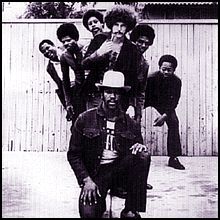![[Sidebar]](/standard/image/sidebar.gif)
![[Music Reviews]](/standard/image/headers/music_reviews_header.gif)
| clubs by night | club directory | bands in town | concerts | hot links | reviews & features |
It's too bad that Rhino Records chose the term "soul" to attract fans to its three-CD collection Brown-Eyed Soul: The Sound of East L.A., 48 songs representing the taste of three generations of Mexican-Americans. The music compiled here embraces many pop genres from a three-decade period (1953-1980), from doo-wop and jump blues to ballads and funky stuff, but almost none of it is soul music. The attitude here is streetwise, skeptical, sentimental -- but always of the material world. The soul genre -- Otis Redding singing "I've Been Loving You Too Long," for example, or the Temptations doing "Can't Get Next to You," Gamble & Huff's songs for the Spinners, O'Jays, and Harold Melvin & the Blue Notes, and James Brown's entire career -- was a sanctified, church-music experience. The soul singer, lover man though he was, raised his hands in the air, giving witness before God to his love and happiness, or to his being cast out and judged. It was a public drama of rhythm and high seriousness, of exhausting melodic intensity. From the 'hood
Digging the sound of East LA
by Michael Freedberg
It's hard to think of more than a few songs on The Sound of East L.A. in which there's any raising of hands. Billy Stewart's "Sitting in the Park" (1965) and, less capably, Tierra's "Together" (1980) and Gene Chandler's "I Fooled You This Time" (1966) display the smooth levitating ecstasy that soul singers worked so hard at. Bloodstone's "Natural High" (1973) echoes, thinly, the I'm-weak-for-you testimony of the falsetto soul style that reached its peak elsewhere, in the work of the Delfonics and the Chi-Lites. Tony Clarke's "The Entertainer" (1965) borrows, for a rather standard tale, the bittersweet melody and supple syncopations that Gamble and Huff used to impart faith and vulnerability to their many Intruders hits.
War
The Stewart song is a classic of the falsetto style that dominated Chicago soul in the '60s, thanks to the work of the Impressions and Dells (and the spare-to-the-bone production style of Billy Davis and Leonard Caston). The CD's other high points lie in a realm apart from soul. There's a large selection of drippy-nosed doo-wop -- the Five Satins' "Our Anniversary" (1957), Don Julian and Meadowlarks' "Heaven and Paradise" (1955), and Little Julian Herrara's "Symbol of Heaven" (1957) are classics of the doo-wop revival that got going almost before the first wave had ended. Nineteen-fifties-style jump blues -- the leg-lifting beat of the Lindy, or jitterbug -- makes an appearance by way of Chuck Higgins's saxophone-led "Pachuko Hop." Junior Walker imported this genre into Motown style, whence it was copied by many -- here by the Olympics in "Mine Exclusively." The work of the post-Eric Burdon version of War exemplifies the snickery, low-riding funk that captured East LA's hot-rodding street scene (but "Low Rider," their most emblematic hot-rod song, isn't included).Most significant, however, are the compilation's many cover versions, such as El Chicano's "Brown Eyed Girl" (1972), Cannibal and the Headhunters' "Land of 1000 Dances" (1965), and the Romancers' "My Heart Cries" (1965). There are also numerous originals that sound palpably unoriginal, derivative of better-known hits: Rosie and Ron falsettoing in "Bring Me Happiness" (1961), El Chicano aping Santana in "Tell Her She's Lovely" (1973), the Premiers Louie-Louie-ing it in "Farmer John" (1964), the Blendells going surf in "La La La La La" (1964), the Midniters sighing "Dreaming Casually" (1967), and the Gallahads crying the doo-wops in "I'm Without a Girlfriend" (1960). It's in these amateurish attempts by second-level bands and singers to sound like the big names that one hears the modesty of a real life "neighborhood," in which no larger-than-life figures turn up. These attempts express passions and longings common to us all -- more credibly, perhaps, for stating their case with all the misspeaks in place. Indeed, when disco got going in the early '70s, in neighborhoods not much different from East LA, it was frequently the honest cloddishness of danceable non-hits that the first DJs preferred.
Perhaps it really was soul music that these DJs -- and the lovers of this compilation's failed songs -- had in mind. And perhaps they couldn't achieve it because they didn't truly believe. So they took to songs that aimed for the skies but fell somewhere short. The effect is of not quite getting what one wants. Of crying over dreams not come true; of laughing at the serious and taking seriously what is most laughable. And doing it over and over, like a dance one can't step out of. Which is why The Sound of East L.A. gains its eloquence from being 48 songs in length. Single after single the less-than-perfect voices say their say and go, like a puff of breath. But at the same time, single after single, the doo-wop, funk, and surf music genres press on, imposing their treble beat and limiting the options of the fans who will dance and sing them dreaming of a love out of reach. Dreaming of a righteous destiny far beyond the neighborhood that, during the pre-disco years in which these songs prevailed, seemed free rather than small -- and that now, in the era of hip-hop, has become tiny and sour with the anger of gangsta payback.
| home page | what's new | search | about the phoenix | feedback |
Copyright © 1997 The Phoenix Media/Communications Group. All rights reserved.
